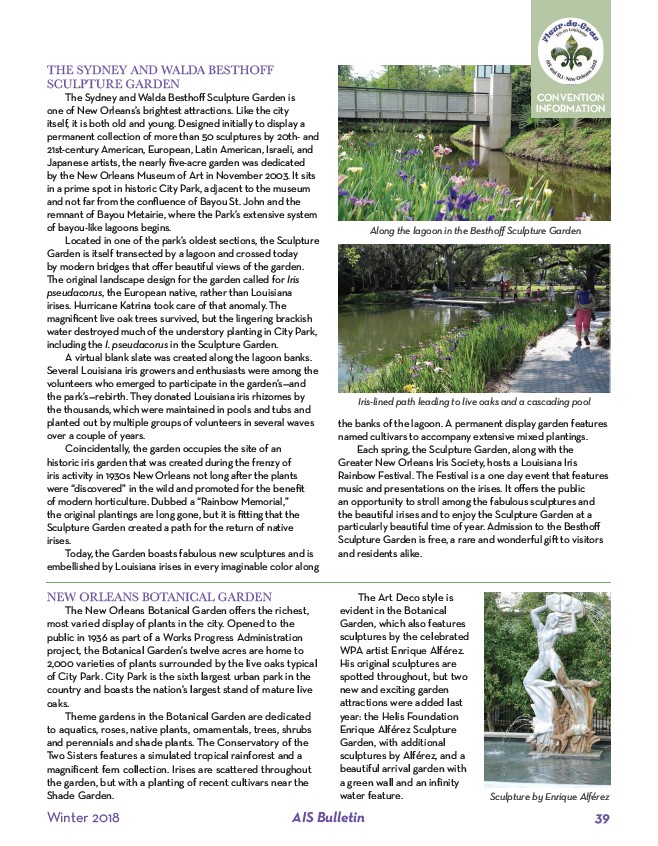
THE SYDNEY AND WALDA BESTHOFF
SCULPTURE GARDEN
The Sydney and Walda Besthoff Sculpture Garden is
one of New Orleans’s brightest attractions. Like the city
itself, it is both old and young. Designed initially to display a
permanent collection of more than 50 sculptures by 20th- and
21st-century American, European, Latin American, Israeli, and
Japanese artists, the nearly five-acre garden was dedicated
by the New Orleans Museum of Art in November 2003. It sits
in a prime spot in historic City Park, adjacent to the museum
and not far from the confluence of Bayou St. John and the
remnant of Bayou Metairie, where the Park’s extensive system
of bayou-like lagoons begins.
Located in one of the park’s oldest sections, the Sculpture
Garden is itself transected by a lagoon and crossed today
by modern bridges that offer beautiful views of the garden.
The original landscape design for the garden called for Iris
pseudacorus, the European native, rather than Louisiana
irises. Hurricane Katrina took care of that anomaly. The
magnificent live oak trees survived, but the lingering brackish
water destroyed much of the understory planting in City Park,
including the I. pseudacorus in the Sculpture Garden.
A virtual blank slate was created along the lagoon banks.
Several Louisiana iris growers and enthusiasts were among the
volunteers who emerged to participate in the garden’s—and
the park’s—rebirth. They donated Louisiana iris rhizomes by
the thousands, which were maintained in pools and tubs and
planted out by multiple groups of volunteers in several waves
over a couple of years.
Coincidentally, the garden occupies the site of an
historic iris garden that was created during the frenzy of
iris activity in 1930s New Orleans not long after the plants
were “discovered” in the wild and promoted for the benefit
of modern horticulture. Dubbed a “Rainbow Memorial,”
the original plantings are long gone, but it is fitting that the
Sculpture Garden created a path for the return of native
irises.
Today, the Garden boasts fabulous new sculptures and is
embellished by Louisiana irises in every imaginable color along
NEW ORLEANS BOTANICAL GARDEN
The New Orleans Botanical Garden offers the richest,
most varied display of plants in the city. Opened to the
public in 1936 as part of a Works Progress Administration
project, the Botanical Garden’s twelve acres are home to
2,000 varieties of plants surrounded by the live oaks typical
of City Park. City Park is the sixth largest urban park in the
country and boasts the nation’s largest stand of mature live
oaks.
Theme gardens in the Botanical Garden are dedicated
to aquatics, roses, native plants, ornamentals, trees, shrubs
and perennials and shade plants. The Conservatory of the
Two Sisters features a simulated tropical rainforest and a
magnificent fern collection. Irises are scattered throughout
the garden, but with a planting of recent cultivars near the
Shade Garden.
CONVENTION
INFORMATION
Along the lagoon in the Besthoff Sculpture Garden
Iris-lined path leading to live oaks and a cascading pool
the banks of the lagoon. A permanent display garden features
named cultivars to accompany extensive mixed plantings.
Each spring, the Sculpture Garden, along with the
Greater New Orleans Iris Society, hosts a Louisiana Iris
Rainbow Festival. The Festival is a one day event that features
music and presentations on the irises. It offers the public
an opportunity to stroll among the fabulous sculptures and
the beautiful irises and to enjoy the Sculpture Garden at a
particularly beautiful time of year. Admission to the Besthoff
Sculpture Garden is free, a rare and wonderful gift to visitors
and residents alike.
The Art Deco style is
evident in the Botanical
Garden, which also features
sculptures by the celebrated
WPA artist Enrique Alférez.
His original sculptures are
spotted throughout, but two
new and exciting garden
attractions were added last
year: the Helis Foundation
Enrique Alférez Sculpture
Garden, with additional
sculptures by Alférez, and a
beautiful arrival garden with
a green wall and an infinity
water feature.
Sculpture by Enrique Alférez
Winter 2018 AIS Bulletin 39